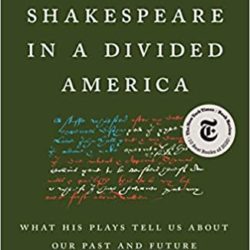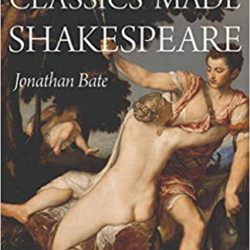In his latest book, Shakespeare in a Divided America: What His Plays Tell Us About Our Past and Future, the esteemed Shakespearean James Shapiro (author of The Year of Lear: Shakespeare in 1606) shifts his focus to America’s fascination with Shakespeare over the past two centuries. This new work of history comes six years after the author edited a notable compendium of short pieces by renowned American poets, presidents, novelists, statesmen, humorists, artists, and critics, titled Shakespeare in America: An Anthology from the Revolution to Now. Acknowledging the impossibility of tackling a complete history of Shakespeare in America, Shapiro aims to “drill down more deeply into eight defining moments in America’s history.” By isolating specific historical episodes dating back to… Read More…
Posts with the category ‘Book Reviews’
Book Review: Shakespeare in a Divided America: What His Plays Tell Us About Our Past and Future (By James Shapiro)
Bate Explores Shakespeare’s Uniquely Elizabethan Debt to the Ancients
Elizabethan audiences had no expectations that the plots invented for the rowdy stages of London playhouses would be completely new and original. When Shakespeare developed the scripts of Julius Caesar, Antony and Cleopatra, and other Roman plays, he adapted his plots from Plutarch’s Lives of the Noble Grecians and Romans. In relying on a historian’s translation of these biographies (which Plutarch wrote for readers in the 1st-century A.D.), Shakespeare followed the literary fashion of his time. In How the Classics Made Shakespeare, the eminent scholar and critic Jonathan Bate nimbly revisits how the world’s greatest playwright relied upon sources like Plutarch and Ovid, but he offers a deeper, erudite investigation into how the sonnets, narrative poems, and plays are inspired by other canonical “ancients” such as Cicero, Horace, Seneca, and Virgil. This latest book cogently builds upon Bate’s ambitious work, Soul of the Age, a biography of Shakespeare’s mind, and his earlier Shakespeare and Ovid.
New Illustrated Edition Reimagines Shakespeare’s “The Tempest” in Verse
Anyone familiar with Charles and Mary Lamb’s 1807 classic, Tales From Shakespeare, will appreciate the motive behind Peter and William Blagys’s new 11- by 17-inch illustrated edition, The Rarer Action: Shakespeare’s The Tempest Retold. As those who tend to be skittish about reading Shakespeare’s plays will discover, this wry, charming retelling of the bard’s most popular romance is much more zany and whimsical than Mary Lamb’s earnest prose adaptation of The Tempest (also adorned by vivid color plates). Both works, however, share an important and practical aim—to recount the adventures of an exiled duke and his young daughter in an entertaining and accessible manner. The Rarer Action is a collaboration between two brothers—writer Peter W. Blagys and illustrator William A. Blagys—and it is a novel retelling of The Tempest with… Read More…




